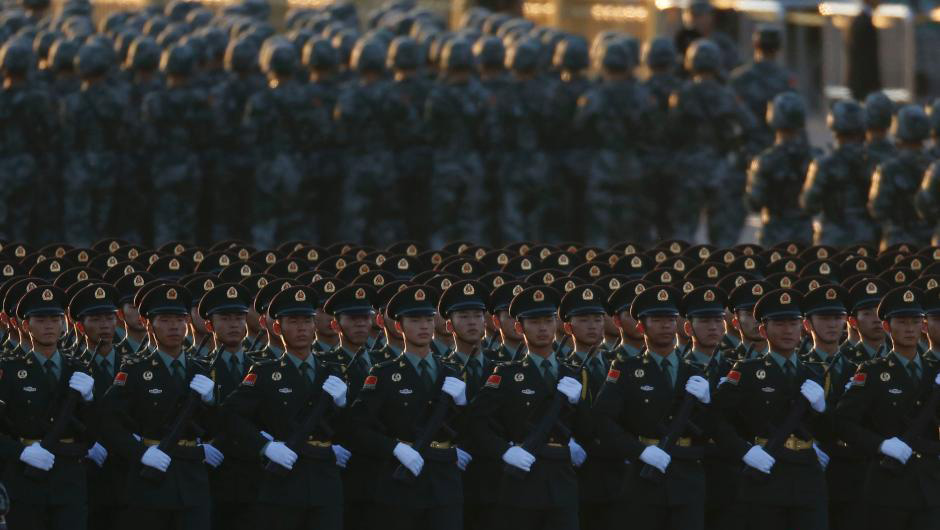V-day parade schedule
 0 Comment(s)
0 Comment(s) Print
Print E-mail China.org.cn, September 3, 2015
E-mail China.org.cn, September 3, 2015
|
|
|
Soldiers prepare for the commemoration activities to mark the 70th anniversary of the victory of the Chinese People's War of Resistance Against Japanese Aggression and the World Anti-Fascist War, in Beijing, capital of China, Sept. 3, 2015. |
I. Greetingof foreign guests
9:00: Chinese President Xi Jinping and his wife Peng Liyuan will greet foreign guests, take photos with them and wait to see the parade on the Tian’anmen Rostrum with them. Leaders and representatives from 49 countries will attend the ceremony, including 30 state and government leaders and 19 senior representatives of foreign governments.
II. Music
A military band and chorus will play and sing songs during the parade. They will be the first to enter the scene and the last to leave. Among the nearly 30 classic songs that will be played, are the Song of the Counter-Japanese Military and Political University, Defending Yellow River, On the Taihang Mountain and The People's Army Is Loyal to the Party.
III. Firing salute and national flag raising
10:00: The ceremony will begin with a salute of 70 guns. The flag of China will be raised, and the national anthem will be sung.
IV. Speech from the Chinese president Chinese President Xi Jinping will deliver a speech.
V. Review troops Chinese President Xi Jinping will review the troops from his car.
VI. Parade (Over 50 minutes)
Air flag guard formations
1. Helicopters carrying the flag of China and the flag of the People's Liberation Army;
2. 20 helicopters forming the figure "70";
3. Seven planes with colored smoke.
2 veteran teams riding in open-top vehicles
1. The team of veterans and children of fallen soldiers;
2. The team of outstanding members of armed forces that supported the front line.
11 formations of foot soldiers
17 formations of foreign troops and representative teams
1. The representative team of Afghan troops
2. The formation of Belarusian troops
3. The team of representative Cambodian troops
4. The formation of Cuban Revolutionary Armed Forces
5. The formation of Egyptian armed forces
6. The team of representative Fijian troops
7. The formation of Kazakhstani armed forces
8. The formation of Kyrgyzstani troops
9. The team representing the Lao People's Army
10. The formation of Mexican armed forces
11. The formation of Mongolian armed forces
12. The formation of Pakistani armed forces
13. The formation of Serbian armed forces
14. The formation ofTajikistani armed forces
15. The team of representative Vanuatu mobile troops
16. The team of representative Venezuelan troops
17. The formation of Russian armed forces
27 formations of weaponry
Formations of weaponrywill be divided intosix modules, includingground assaultweaponry, air defense and anti-missileweaponry, offshore assault and defense weaponry, strategic strike weaponry, information equipmentand logisticequipment.
Module I: Ground assault troops
1. The formation of tanks
2. The formation of amphibious assault vehicles
3. The formation of caterpillar infantry fighting vehicles
4. The formation of airborne fighting vehicles
5. The formation of antitank missiles
6. The formation of self-propelled artilleries
7. The formation of armored assault vehicles
8. The formation of light assault vehicles
9.The formation of anti-terrorist vehicles
Module II: Air defense and anti-missile troops
10. The formation of anti-aircraft artilleries
11. The first formation of ground-air missiles
12. The second formation of ground-air missiles
Module III: Offshore assault and defense troops
13. The formation of ship-to-air missiles
14. The formation of anti-ship missiles
15. The formation of shore-to-ship missiles
Module IV: Strategic strike forces
16. The first formation of conventional missiles (medium and short-range missiles)
17. The second formation of conventional missiles (anti-ship ballistic missiles)
18. The third formation of conventional missiles (ground-to-ground cruise missiles)
19. The formation of nuclear and conventional missiles (medium and long-range ballistic missiles)
20. The first formation of nuclear missiles
21. The second formation of nuclear missiles
Module V: Information forces
22. The formation of early-warning radars
23. The formation of drones
24. The formation of communication equipment
Module VI: Logistic forces
25. The formation of logistic supply equipment
26. The formation of maintenance vehicles
27. The formation of medical service vehicles
10 Echelon aircraft formations (one flying during the opening and nine in the ending sequence)
1. The leading aircraft echelon
2. The AEW, or Airborne Early-Warning Aircraft, echelon
3. The maritime patrol aircraft echelon
4. The bomber echelon
5. The refueling and receiver echelon
6. The first fighter echelon
7. The second fighter echelon
8. The carrier-based aircraft echelon
9. The helicopter echelon (including colored smoke)
VII. Flying pigeons After the last aircraft echelon flies over Tian’anmen Square, tens of thousands of pigeons and balloons will fly into the sky.
May the world always be at peace!







Go to Forum >>0 Comment(s)